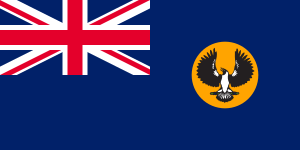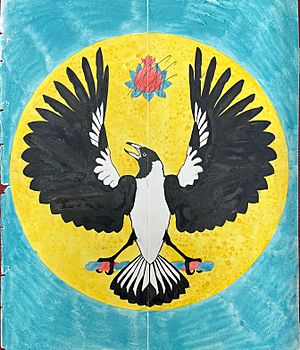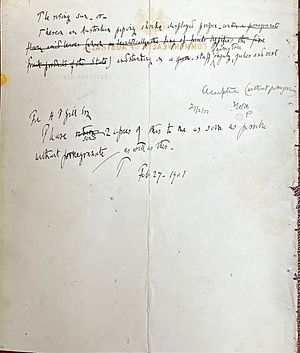Piping shrike facts for kids
The badge on the Flag of South Australia shows a rising sun and a bird called a Piping Shrike. This bird is actually a type of Australian Magpie known as the White-backed Magpie. People sometimes get confused because they think the bird on the flag is facing forward, but it's actually showing its back! The name "Piping Shrike" was used by the South Australian Governor a long time ago. The word "Piping" in its name comes from its scientific name, Gymnorhina tibicen telonocua, where tibicen means "piper" or "piping."
Contents
How the Piping Shrike Got on the Flag
The Piping Shrike first appeared on the Governor's flag in 1903. It was also on the State Badge, which was officially announced in 1904. Many people believe Harry Pelling Gill, who was the director of the School of Arts, designed it. He may have received some ideas from the Governor General Hallam Tennyson, 2nd Baron Tennyson.
However, other people also claimed to have designed it. The nephew of Robert Craig from the School of Arts said he created the original design. Relatives of Adelaide artist Frances Jane Warhurst also said she designed it. She supposedly based it on an eagle from the seal of a Prussian consul, who was her friend.
A later version of the badge was also credited to Gill in 1910. The design shows the bird against a yellow rising sun. This design became part of the state flag in 1904 and the Coat of Arms in 1984. The name "Piping Shrike" was already a common nickname for the Australian Magpie before it became official.
How the State Badge Was Approved
On Wednesday, February 27, 1901, a painting by H.P. Gill was approved. This painting became the design for the new State Badge for South Australia. Both the Governor and the Premier of South Australia accepted it.
The Premier wrote "Accepted (without pomegranate)" on the back of the painting. The Governor also wrote a description of the design. He described "The rising sun – or – Thereon an Australian piping shrike displayed proper – under a pomegranate flower amid leaves and standing on a gum-staff, raguly, gules and vert." (This means: or = gold, displayed proper = in its natural colours, raguly = with oblique lines, gules = red, vert = green). The Governor removed the pomegranate and changed "gum-staff" to "staff of gum tree."
When you look at the bird on the flag, you are seeing its back. You can tell this because the bird's tail is positioned over the back of the gum-tree branch. The bird's head is turned to its left.
Identifying the Bird
Official reports say the Piping Shrike is an Australian Magpie. Government sources specifically name it as the White-backed Magpie (Gymnorhina tibicen leuconota). The scientific name Gymnorhina tibicen telonocua is for a type of Australian Magpie found mostly in South Australia. The common name for Gymnorhina tibicen leuconota is the White-backed Magpie.
The name "Piping Shrike" is not often found in modern bird books. However, it is still sometimes used locally because of its long history on the South Australian flag.
Professor Gisela Kaplan, an expert on Australian Magpies, explained why there has been confusion. She said, "Confusion has arisen about the state emblem because it is easy to think one is viewing the front of the bird. Once one realises that one is viewing the back of the bird, one can see all the distinguishing features of the White-backed Magpie. The bird on the SA State Flag is without doubt a White-backed Magpie.”
The Governor's handwriting on the back of the original painting calls the bird "Australian piping shrike." Since Professor Kaplan confirmed it is a White-backed Magpie, there is no doubt about the bird's identity.
The explorer Charles Sturt wrote about this bird in the 1840s. He observed:
- "GYMNORHINA LEUCONOTA GOULD., The White-backed Crow Shrike. This bird is somewhat larger than, and very much resembles a magpie, but the proportion of white is greater, and there is no metallic or varied tint on the black feathers as on the European bird. In South Australia it is a winter bird, and his clear fine note was always the most heard on the coldest morning, as if that temperature best suited him. All the species of this genus are easily domesticated, and learn to pipe tunes. They are mischievous birds about a house, but are useful in a garden. I had one that ranged the fields to a great distance round the house, but always returned to sleep in it."
This observation compares the White-backed Crow Shrike (an older name for the White-backed Magpie) to the Eurasian Magpie.
Over time, Australian Magpies were called "Crow," "Shrike," and "Magpie." Early European settlers gave them these names because they thought the birds looked similar to birds in Europe. However, we now know that the Australian Magpie is not closely related to European Magpies, Crows, or Shrikes. It is actually most closely related to Australian butcherbirds.
The common names "Piping Crow-Shrike" and "White-backed Crow-Shrike" eventually became less popular. They were replaced by "Black-backed Magpie" and "White-backed Magpie."
In his 1907 book, “Useful Birds of Southern Australia,” Robert Hall said that "Magpie" was not the correct name. He argued that "Piping Crow-Shrike" and "White-backed Crow-Shrike" were better names. However, he decided to use the popular names "White-backed Magpie" and "Black-backed Magpie" in his book. He also noted that the two birds seemed to be different types of the same species.
Today, the scientific name Gymnorhina tibicen is used for all types of this species. The word tibicen means "piping," which is a very fitting name.
Many bird books and historical records mention "Piping Shrike" as another name for the Australian Magpie. For example, "Handbook of Australian, New Zealand and Antarctic birds" lists it. "Australian Bird Names Origins and Meanings" also includes "Piping Shrike" for the White-backed Magpie. Shane Parker, Curator of Birds at the South Australian Museum, states that the White-backed Magpie is the "piping shrike" of South Australia’s badge. The Wakefield Companion to South Australian History also confirms this.
Why There Has Been Confusion
There have been some misunderstandings about the Piping Shrike.
ABC 891 Adelaide Afternoons Podcast
An ABC podcast called “Does our state emblem, the piping shrike, actually exist?” discussed this topic. Professor Gisela Kaplan, an expert on Australian Magpies, was interviewed. She found it hard to identify the bird at first because she didn't realize the image showed the back of the bird. She also noted that the name "Piping Shrike" doesn't appear in most modern bird books. However, as mentioned earlier, several books do recognize it as a local name or the name for the bird on the state flag.
A heraldry expert was also interviewed. He explained that in heraldry, it's okay to stylize an image. He did not say the bird on the flag was stylized. He simply stated that the bird on our flag was a Piping Shrike, or White-backed Magpie.
The podcast summary made some incorrect conclusions. One was that the Piping Shrike image was stylized, suggesting it couldn't be identified. Another was that the Piping Shrike was not a real bird. These mistakes happened because they didn't realize the image shows the back of the bird.
In 2020, Professor Kaplan clarified her comments. She said her statements were only meant to explain that the name "Piping Shrike" is not in today's bird books. She did not mean that a bird once called a "Piping Shrike" does not exist or is not a real bird. She repeated: "Once one realises that one is viewing the back of the bird, one can see all the distinguishing features of the White Backed Magpie. The bird on the SA State Flag is without doubt a White Backed magpie.”
The summary of the ABC podcast has not been changed on their website.
BankSA Piping Shrike Advertisements
BankSA uses the Piping Shrike in some of its advertisements. However, the bird in these ads is often based on the wrong bird. It looks like a Magpie-lark, but it should look like a White-backed Magpie. The bird in the ads often faces the viewer, with its wings raised and head turned to its right. This suggests that the ad designer made the common mistake of thinking the bird on the flag faces forward. Remember, the image on our flag shows the back of the bird, and its head is always turned to its left.





